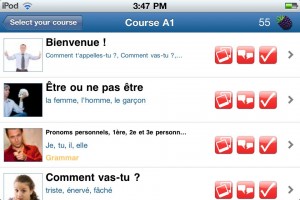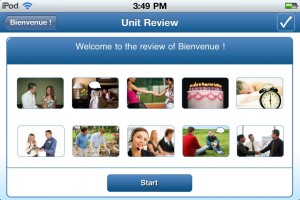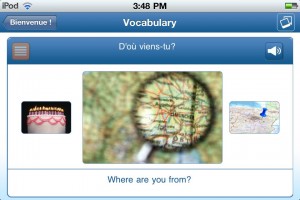
by John Fotheringham
Just as the printing press democratized access to the written word, ebooks are again revolutionizing how information is produced, distributed and consumed. Even successful authors, whose very livelihoods have depended on the sale of dead-tree books (e.g. Timothy Ferriss, author of The 4-Hour Workweek and The Four-Hour Body, and Seth Godin, author of Tribes, Permission Marketing, and All Marketers are Liars) have seen the writing on the literary wall, and agree that “print is dead”, or at least “dying fast”…
Here are a few reasons why the ebook is beating print books to a “pulp” (pun intended):
- Lower Production & Distribution Costs: This allows for lower retail prices, putting books in the hands of more and more readers. And many ebooks are available at no cost at all, including literary classics no longer covered by copyright (e.g. Project Gutenberg) and new works that are free by choice (this is one of the common “freemium” strategies where an ebook is used for free marketing to promote other paid content or services.)
- Read Anytime, Anywhere: You can literally carry thousands of ebooks with you on your mobile device or ebook reader. Language learning is then just a click away whether you are on the bus, a plane, or bored to tears in a meeting. And if you forgot to download books at home, you can always download more on the go via WiFi or even 3G networks.
- More Time Efficient: Many ebook readers allow you to easily cut and paste words and even look up unknown terms using built in dictionaries. This can save the learner hours and hours, especially in ideographic languages that usually require looking up characters by strokes, radicals, or handwritten input.
So now that I’ve made the case for ebooks, let’s look at my two favorite weapons of choice for using ebooks in foreign language learning:
Best Ebook Readers
There are heaps of ebook reader devices on the market today (the Amazon Kindle, the iPad, the Sony PRS series, the Barnes & Noble Nook, etc.), as well as numerous ebook reader apps available for Android devices, iPhones, iPads, iPod touches, Blackberry devices, PCs and Macs. After trying out hundreds of different devices at last year’s CES and stealing…I mean “borrowing”…a few of my friend’s devices for further testing, here are my two finalists:
1st Place: The Amazon Kindle 3G
Price:
- Kindle 3G: $189 USD
- Kindle (WiFi version): $139 USD
Where to get ‘em: Available from Amazon.com
While I am a full-fledged Apple fanboy, I must give Amazon credit where credit is due. Despite serious competition from the Apple iPad, Sony’s various ebook readers, and myriad other me-too products, the Kindle remains a hot seller, and my humble opinion, the world’s best ebook reader.
Here’s what I love most about the Kindle:
1) E ink is easy on the eyes and your battery. Unlike the pixels used on computers and smartphones (which can wreak havoc on your eyes and zap your battery), the Kindle’s use of E Ink creates a reading experience pretty darn close to physical books, all while consuming very little battery life. They accomplish this amazing feat by employing millions of itsy-bitsy, electronically charged “microcapsules”, within which there are tons of little black pigment pieces and white (or rather, light gray) pigment pieces. Text is produced by causing the black pigments to run to the top of specific microcapsules, while the background is created when the gray pigment is forced to the top. The Kindle display is also much easier to read outside in the sun, while most other devices (including the iPad, iPhone, and iPod touch) suffer from serious glare problems.
2) Direct access to the world’s largest book store pretty much anywhere in the world. Users can wirelessly access over 750,000 ebooks, plus heaps of audiobooks, newspapers, magazines and blogs, in over 100 countries worldwide. And unlike the iPad, the 3G wireless connectivity is provided free of charge.
3) Great Apple and Android apps. If you don’t want to fork over the funds for a Kindle, or you already own one but don’t feel like lugging it around all the time, you can always just download the Kindle app.
Download the free Kindle app (Android, Apple iPhone, iPad, iPod touch, Blackberry, PC, or Mac)
2nd Place: iBooks on the Apple iPad, iPhone & iPod touch
Prices:
- iBooks: free download in iTunes
- iPod touch: $229 USD (8GB), $299 (32GB), and $399 (64GB)
- iPad (WiFi): $499 USD (16GB), $599 USD (32GB), and $699 USD (64GB)
- iPad (3G): $629 USD (16GB), $729 USD (32GB), and $829 USD (64GB)
Where to get ‘em: Apple retail stores, the Apple Online Store, Amazon, Target, WallMart, AT&T Stores, Verizon Stores (iPad is available now; iPhones will allegedly be available through Verizon in early 2011…).
1) More than JUST an ebook reader. My only gripe with the Kindle is that it is only an ebook reader. With the iPad, iPhone, or iPod touch, on the other hand, your device is only limited by the apps you download to it. I currently have about 100 hundred apps on my iPod touch, including Skype for calling tutors and language partners, Evernote for keeping notes of new words and phrases, iLingQ, ChinesePod, SpanishPod, and on, and on, and on…
2) Sexy, intuitive user interface. The Kindle interface isn’t bad by any measure, but it pales in comparison to the rich, elegant design of Apple iBooks. The new “retina display”, available on the iPhone 4, iPod touches (4th gen), and likely the next vesion of the iPad, creates extremely crisp, vivid images, and makes reading text far easier than on lower resolution devices.
3) Excellent built in dictionary, bookmarks, highlighting and search features. iBook’s built in dictionary, bookmarks and highlighting tools are a thing of beauty. To look up a term, you need simply tap the word and then click “Dictionary” from the pop-up menu. To highlight, you again just tap a word and then drag the handles to the left or right to select the words or sentences you want. Bookmarking requires just a quick tap in the upper right corner. Best of all, you can then quickly go back to your saved highlights or bookmarks using the table of contents tab. Also, you can use the search feature to quickly find all instances of a particular word (a very useful feature for language learners as it allows you to quickly see how a particular word is used in context.)
Getting the Most Out of Ebook Readers
As we’ve seen, ebooks and ebook readers are wonderful language learning tools indeed. But as ESLpod’s Dr. Jeff McQuillan puts it, “A fool with a tool is still a fool.” Here then, are some tips on how to best apply these amazing new tools.
1) Don’t fall into the trap of reading more than you listen. Reading is an important part of language acquisition, and is an essential component of learning how to write well in a foreign language. But remember that listening and speaking should be the focus of language study, especially in the early stages of learning. It is all too easy to spend too more time with your nose in a book than listening to and communicating with native speakers, especially for introverts and those who have been studying for too long with traditional, grammar and translation based approaches.
2) Read an entire page before looking up unknown words. Lest you get distracted and lost in the details, I suggest making at least one full pass through each page in your ebook before looking up unfamiliar words.
3) Choose books that are just a tad beyond your comprehension level. By “comprehensible” I mean that you can understand about 70 to 85% of the text. Too far above or below this and you will quickly get bored and likely give up.
4) Use the Kindle’s Text-to-Speech Tool. The Kindle and Kindle 3G can literally read English-language content out loud to you. Use this feature when you are doing other tasks that require your vision but not your ears, and as a way of building your listening comprehension. I suggest listening to a passage first and then reading to back up your comprehension.
5) Get audio book versions of ebooks you read. While the Kindle’s text-to-speech tool works well, it can get a bit monotonous with its robotic pronunciation. For longer books, I suggest buying the audio book version the book, which tend to be read by professional voice actors, and are therefore far easier to listen to… Audio books are available from Audible, iTunes, and countless other site, and make sure to check out the free Audiobooks app for the iPhone, iPad and iPod touch.
]]>This tome of language awesomeness contains over 500 pages of language learning advice, tips, and success stories, with contributions from 43 authors, including Moses McCormick, Steve Kaufmann, Benny Lewis, Stuart Jay Raj, and countless others language heroes.
The book is the brainchild of Claude Cartaginese of Syzygy on Languages, who also edited the work. In his own words, The Polyglot Project is:
“…a book written entirely by YouTube Polyglots and language learners. In it, they explain their foreign language learning methodologies. It is motivating, informative and (dare one say) almost encyclopedic in its scope. There is nothing else like it.”
And here is an entertaining video announcement about the book’s release from Claude:
Buy “The Polyglot Project” on Amazon
Download a free PDF of “The Polyglot Project”
Download my chapter of the “The Polyglot Project” (I fixed some typos that made it into the book…)
]]>Busuu.com is a fast growing online language learning community with over a million users as of early October 2010. The site is named after a Cameroon language of the same name, which according to their website, is now spoken by only 8 living people!
All in all, the site is very similar (in a good way) to LiveMocha (read my review of LiveMocha here). Both use a “freemium” model, offering both free and premium services, which is great for new users who want to get their language learning feet wet before committing to a monthly credit card charge. Both are social networks, relying upon and benefiting from crowd sourcing to correct user writing samples, provide conversation practice, etc. There are, however, many subtle differences between the two sites; some good, some bad…
The Good
1) Excellent User Interface.
I love Busuu’s Language Garden visual shown on your personalized landing page (you’ll see it once you have registered). It’s attractive, intuitive and a pleasant departure from other sites that just show a boring table or list.
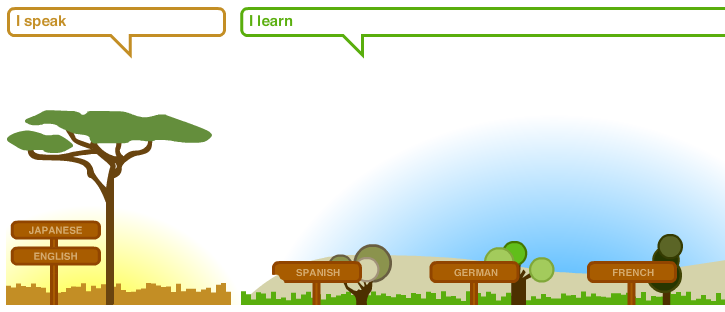
Busuu also uses high-quality stock photography that does a good job of creating a clear visual context. Rosetta Stone and LiveMocha also use a similar approach, but I find that they often use unclear pictures, leaving the learner a little confused about what concept, idea, or vocabulary item they are trying to impart. From what I have seen, this doesn’t seem to be as much of a problem on Busuu.
One of my favorite little features is the blinking icon effect showing which section of the lesson is next (the system will keep track of which sections you have already completed and then show you what to do next.)

2) Conversational beginner materials.
From the very first lesson, you will be hearing and reading natural (albeit simple) phrases like “How’s it going?”, “Where are you from?”, and “I’m sorry, I didn’t know she was your sister!” Okay, I made up the last one…
This is in contrast to LiveMocha, which starts off with a number of simple, declarative sentences to demonstrate certain simple adjectives, pronouns, etc. (e.g. He is tall. She is short. The man is fat. The girl is thin.) The idea of course is to get you used to how the language works and introduce basic vocabulary within a sentence. The problem is that most beginning language learners want to learn some useful phrases as well so they can actually say something once they arrive in the foreign country. You are fat probably won’t get you very far at a bar…
3) Great iPhone / iPod touch app.
The Busuu apps are extremely well designed, and as far as I can tell, include nearly all the content available on the website. As is often the case, I actually prefer using the app version over the website equivalent as it is more tactile and their are fewer visual distractions (less screen real-estate forces the designers to only include what is absolutely necessary.) And best of all, the apps are free!
The Bad
1) Annoying AdSense advertisements.
I completely understand the need to monetize the website, but random, third-party banners are not the answer. I, like many people in my generation, instinctively tune such ads out and will NEVER click them no matter how many times they flash in my face. I think Busuu would be better off placing more ads for their premium offerings as LiveMocha does.
2) Annoying comprehension questions.
Some comprehension questions ask information about specific people mentioned in the dialogue. I would much prefer exercises that reinforced the vocabulary and grammatical structures, not specific biographical information about characters. Better yet, they could present a number of dialogues using different characters and content information, but based around the same phrases and structures. Called “narrow listening”, this approach would help improve intake and retention, while also reducing the monotony involved in listening to the same piece of audio again and again.
3) A few too many bad apples…
On multiple occasions, users who agreed to “correct” my writing samples would simply copy what I wrote and paste it in the comments with no changes or comments whatsoever. I assume they did this in an effort to quickly earn “Busuu Berries”, points that can be exchanged for otherwise pay-only services on the site. Busuu needs to figure out a better way to patrol feedback. My suggestion is that they only assign points after the author of the writing sample has thumbed up the feedback.
My Verdict
 If you are looking for a good free language learning solution online and are not learning a less common language (at the time of writing, Busuu only offers materials for a handful of major languages), then I definitely suggest checking out Busuu.com Now if they only offered the Busuu language itself… It would be great to become the 9th speaker!
If you are looking for a good free language learning solution online and are not learning a less common language (at the time of writing, Busuu only offers materials for a handful of major languages), then I definitely suggest checking out Busuu.com Now if they only offered the Busuu language itself… It would be great to become the 9th speaker!
I am a big fan of the Get-it-done Guy podcast and have applied his tips to great success in business, relationships, and yes, language learning. Stever Robbins, the man behind the Get-it-done Guy persona, has now combined his best tips on productivity into a new book titled 9 Steps to Work Less and Do More (available on September 14, 2010).
Stever sent me a PDF version of the book’s first chapter (download it here for free), and it promises to be a wonderful tool for language learning. The most commonly cited reason for not learning a foreign language is, “I don’t have the time”, and the book’s 9 steps each provide practical, no BS ways to not only free up extra time, but fill the new time with meaningful, goal-based pursuits, not just more busyness.
The 9 Steps
Alcoholics have a 12-step approach to overcoming their addiction. Stever, in typical fashion, has provided us with an even more streamlined approach to fight our addiction to unproductive busyness:
- STEP 1: Live on Purpose.
- STEP 2: Stop Procrastinating.
- STEP 3: Conquer Technology.
- STEP 4: Beat Distractions to Cultivate Focus.
- STEP 5: Stay Organized.
- STEP 6: Stop Wasting Time.
- STEP 7: Optimize.
- STEP 8: Build Stronger Relationships.
- STEP 9: Leverage.
I have read chapter one, and can’t wait to get the book on Wednesday and read the rest of the steps! For those of you who end up reading it, please leave comments below about how you have applied Stever’s tips for language learning.
A Note to English Language Learners
The Get-it-done Guy podcast, along with the other programs in the “Quick and Dirty Tips” network, are wonderful resources for English language learners as each podcast episode includes a free transcript. This not only provides two channels of input, but also makes it easier to look up and save unknown words.
And don’t miss the best Get-it-done Guy podcast episode of all time ; ) , How to Learn a Language Quickly (featuring tips from yours truly!)
]]>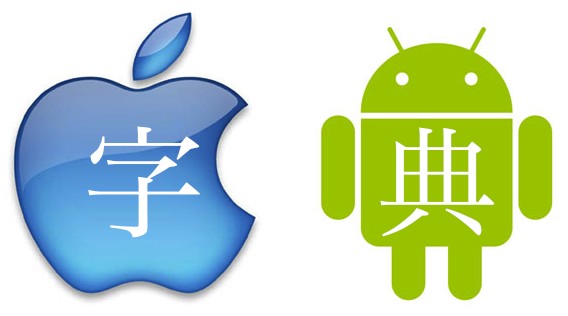
A quick search in the Android Marketplace or Apple App store reveals pages and pages of Chinese dictionaries, including free, ad supported versions, as well as paid apps between $1 and $20 USD. After sampling a number of them, I have settled in on two favorites that seem to be the easiest to use, have the most features, and offer both free and pro versions:
Best Chinese Dictionary App on Android
So far, my favorite Chinese dictionary for Android is Hanping Ch-En. There is a free version and a paid version for £4.99 (about $7.75 USD).
Here is a list of the features I like best (as available on version 2.2.6 Pro):
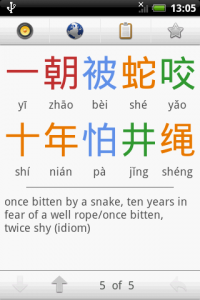 Traditional and simplified Chinese characters.
Traditional and simplified Chinese characters.- Search by Chinese characters, Hanyu Pinyin, English terms (install the free “HanWriting IME” app so you can actually write characters by hand like on an iPod Touch, iPhone or iPad).
- Search for characters in the beginning, middle or end of a term (click the little wrench icon to right of the search field to change this setting.)
- Pinyin is shown right below each character on the detail page.
- Chinese count words are shown when appropriate (e.g. 個, 雙, 台, etc.)
- Drill down on individual characters within multiple character words.
- Audio versions of Chinese terms.
- Shortcut to more details, sample sentences, Google dictionary and Wiktionary via the Android browser.
- Shortcut to “save to clipboard” so you can paste into emails, text messages, other dictionaries, etc.
Best Chinese Dictionary App on iOS4
My favorite app for iPod Touches, iPhones and iPads is KTdict C-E. There is a free version and a pro version for $3.99.
Here are the top features as I see it (as available on version 1.6.1 Pro):
 Beautiful UI (user interface) as one would expect on an Apple device.
Beautiful UI (user interface) as one would expect on an Apple device.- Traditional and simplified Chinese characters.
- Search by Chinese characters (which is a breeze with Apple’s handwriting input), Hanyu Pinyin, and English.
- Drill down on individual characters within multiple character words. Each character can then be copied to the clip board, looked up in the dictionary by itself, or searched within Google, Baidu, Wikipedia (English and Chinese versions), Unihan, Wiktionary, and Dictionary.com (this feature alone is well worth the money!)
- Words you search for are automatically added to the history so you can easily review them later.
- The “Trainer” feature quizes you on words you’ve saved as flashcards. You can create flashcards with the search results, from your favorited terms, and from words in your history.
 The Polyglot Project is a new online reading tool with pop-up translations when you double click on words. The site is still in its infancy, but holds a lot of promise if they continue to expand their library and languages as their website promises.
The Polyglot Project is a new online reading tool with pop-up translations when you double click on words. The site is still in its infancy, but holds a lot of promise if they continue to expand their library and languages as their website promises.
As always, here are the pros and cons of the site as I see them:
The Good
It’s free & easy to sign up: As it stands, the site is completely free and it only requires you to fill in an email, password and your native language. That’s it.
Intuitive, easy to use design: Once you’re logged in, you just pick a book from the library, and begin reading. To look up a word, simply double-click on it and the translation in your native tongue will pop-up briefly.
Navigation shortcuts: Instead of clicking the next or back arrows, you cut just press the “n” or “p” keys for “next” and “previous” respectively.
Simple pop-ups: Many dictionary pop-up systems show too much information, which not only slows down the interface, but also slows down you the learner. There is no chance to get lost or distracted as The Polyglot Project only flashes a single word translation for a short time.
System memory: The system automatically adds any books or languages you’ve browsed to your account dashboard so you can quickly jump back to what you were previously reading. You can of course delete books or languages you no longer wish to view.
The Bad
Limited titles: So far, there are only a few titles available on the site, and they are all literary classics. I like the classics just as much as anyone, but they probably aren’t the best choice for someone just starting out in a language. For starters, they tend to use archaic vocabulary and structures no longer used in the modern language (which is of little use for someone trying to communicate with native speakers. I much prefer getting a firm handle on the modern language before delving into the classics. I hope they will soon add some modern fiction and non-fiction to the mix.
Limited languages: So far, the site only offers four Indo-European languages: German, Spanish, Italian and French. As an Asiaphile, I would greatly like to see Chinese, Japanese, and Korean join the list, as well as other top-ten, must-learn languages like Arabic. I understand, however, that each of these languages poses serious technical challenges: since they don’t naturally include spacing between words, it makes it hard for pop-up dictionaries to parse between different terms.
No way to save vocabulary: In its current design, there is no way to save and then later review words you have looked up. This is my favorite part of using sites like LingQ and I have come to expect it in foreign language reading sites.
Reading only: Reading is a wonderful tool for improving your vocabulary and writing skills, but it should take a back seat to (or at least be supplemented by an equal portion of) listening. This is especially true when you just start out in a foreign language. Many language learners spend far too much time reading and not enough time listening, leading to big vocabularies and strong reading and writing skills, but often causing poor listening skills and strange pronunciation patterns (i.e. they say words how they think they are pronounced based on reading, not how native speakers actually pronounce them).
The Verdict
The Polyglot Project is definitely worth checking out, and acts as a good supplement to your other foreign language learning activities. If they are able to expand their library with modern books and additional languages, they will have created a very powerful language tool, and will likely attract a strong following.
]]> YellowBridge (黃橋 HuángQiáo) is one of the best online Chinese dictionaries available today. When I studying on or near my computer, it is the first place I go if confronted by new Chinese vocabulary or characters. (If you are studying on the go, however, check out my article on the best Chinese dictionary apps for Android and iOS4)
YellowBridge (黃橋 HuángQiáo) is one of the best online Chinese dictionaries available today. When I studying on or near my computer, it is the first place I go if confronted by new Chinese vocabulary or characters. (If you are studying on the go, however, check out my article on the best Chinese dictionary apps for Android and iOS4)
Here’s a rundown of the good and the bad of YellowBridge:
The Good
- It’s free! For being so feature-rich, we are lucky to have access to Yellow-Bridge for a grand total of zero dollars.
- Audio recordings: This wonderfully useful feature used to be available only to paid members, but is now free to everyone. Hurray! Just click the speech bubble below each term to hear it pronounced.
- Presentation of both Simplified & Traditional Chinese Characters: This is a Godsend. While most Chinese learners end up learning “Simplified Characters” (简体字 JiǎnTǐ Zì) since they are what’s used in Mainland China, I highly recommend that you also learn “Traditional Characters” (繁體字 FánTǐ Zì). Not only the traditional forms still used in Taiwan, Hong Kong, and many Chinese communities across the globe, but they give you direct access to ancient Chinese culture. And if you are going to learn both, it is far easier to go “downhill”, that is, starting with the traditional forms and then moving onto their simplified counterparts.
- Multiple search options: You can search from Chinese to English, English to Chinese, and even Pinyin to Chinese.
- Break down of character radicals and components: This is a linguists dream. YellowBridge includes links to the etymological origins of each semantic or phonetic chunk. Be careful though; it is easy to get lost in the details and forget what you originally went there to look up!
- Animated stroke order: This is an amazingly powerful tool that used to available on only the most expensive electronic dictionaries. Now it’s free online. If only I had started learning Chinese characters ten years later…
The Bad
There are few things to complain about with YellowBridge. There are, however, a few things missing that I hope they eventually add to the mix:
- Example sentences: It’s always helpful to see how a given word is used in a sentence, especially when looking up less common words, or terms with multiple meanings.
- Ability to translate entire phrases: As it stands, YellowBridge, like most dictionaries, only translates words and cannot parse complete phrases or sentences as Google Translate does. It would be great if they could someday add this feature, lest otherwise faithful users jump ship and swim toward Googler shores…
- A mobile app: I usually need dictionaries most when I’m out on the go and see something on a sign, in a food menu, or struggle to communicate a particular word with the person across the table at a coffee shop. While you can of course access the dictionary via your mobile device’s web browser, it would make life much easier if they developed a mobile version for iPod Touch/iPhone, Android, etc.
Enjoy!
____
]]> In this interview with Clint Schmidt, LiveMocha’s VP of Marketing & Product, he explains what makes LiveMocha special, introduces some exciting new products coming down the pipe, and responds to some of my grilling questions about the role of grammar in language learning.
In this interview with Clint Schmidt, LiveMocha’s VP of Marketing & Product, he explains what makes LiveMocha special, introduces some exciting new products coming down the pipe, and responds to some of my grilling questions about the role of grammar in language learning.
Listen
This interview was recorded on May 12, 2010. It has been edited for time. Click the red arrow to listen:
____
Read
For those of you using these materials as English learning materials, time stamps have been added to make it easier to go back and review certain sections.
| John Fotheringham: This is episode 4 of the Foreign Language Mastery podcast. I’m your host, John Fotheringham. In today’s show, I interview Clint Schmidt, vice president of marketing and product at LiveMocha. For show notes and a transcript, go to languagemastery.com. Here is the phone interview originally recorded on May 12, 2010.
So why don’t we start out, maybe you can just give my listeners a brief overview of LiveMocha, what it’s like, how it’s different from other sites? And then I’ll go on to some specific questions then. Clint Schmidt: Sure. LiveMocha is the world’s largest online language learning community with free and paid online language courses in 35 languages and more than 5 million members from over 200 countries around the world. LiveMocha is growing very rapidly and really quite virally around the world. A lot of them are word of mouth and recommendations from LiveMocha members. |
|
| 01:15 | I think people are enthusiastic about LiveMocha because it’s really different from alternative or conventional language learning approaches. We studied some traditional self-study language products to understand why they were so ineffective. And we identified two critical elements that were lacking; motivation, sustained motivation, and opportunities to practice the language with another person. And we created LiveMocha to deliver both of those elements and to make language learning more fun and more effective and more social.
So each of our structured online courses include speaking and writing exercises that are reviewed by native speakers of the language that you’re learning. And those folks provide helpful tips for you to improve your language skills. And in returning the favor, you can help them learn your native language. So it’s community-driven learning and it’s all based on reciprocity. And it’s really exciting and it’s a very distinctive way to learn. |
| 02:36 | John Fotheringham: Yah, I’ve actually done a few of the corrections already on the site, a couple of people, you know, it pops up on the screen, “Would you like to correct so-on-so’s writing sample?” So you mentioned about motivation being one of the biggest problems with traditional language learning, which is absolutely true. How specifically does LiveMocha keep people motivated?
Clint Schmidt: Part of the motivation problem, we found, is that it’s just boring to use some of the more traditional self-study methods. They give you a book. They trust that you’re going to read the book, and then you’re going to memorize it, and then you’re going to talk to yourself out loud in your room, in the closet or in your car. Wherever it is, you’re just going to talk to yourself, and that gets boring. It’s like homework without the teacher: you know if the teacher is not going to review it, you don’t do it. |
| 03:30 | A couple of things that are motivating about LiveMocha; number 1, you know somebody is going to review your spoken and written French, or your spoken and written Russian right there. Somebody who is actually going to be there to review it. So you want to do a good job. It motivates you to do your best work, if you know that somebody else will review it.
But it’s also motivating in another important way in that you’re actually working with real people. And these people are helping you over the course of time, repeatedly, make your way to the lessons. Perhaps you’re helping them as well to learn your native language. And you start to develop a bit of a rapport with people. And that rapport brings the social element back to language learning. Imagine that: being social as a part of language learning. It helps keep people engaged. It helps keep people excited. It helps make it fun and bring a real person and a real character and a real interaction into the equation. And it doesn’t make it so brutally boring to go back and pick up that book again. Instead, it’s fun, interactive exercises with people there to help you along. We started to change the whole approach to make motivation no longer an issue. |
| 04:45 | John Fotheringham: Now, how do you guys account for quality control for tutors and for things like that? It’s obviously crowd source. It’s anyone who wants to help can help. But if you get a case where there’s a tutor who is giving blatantly bad advice or is being offensive or whatever, do you have a means to control that?
Clint Schmidt: Absolutely. So I can answer that in a couple of ways. First the easiest answer to give is that if somebody says anything inappropriate or just not very nice perhaps, you can easily block any user on LiveMocha. When you do that, you will never see that person on LiveMocha again anywhere. They won’t appear to you in the community. In fact if a specific member of LiveMocha is blocked by many others, we automatically remove them from the community entirely. And so it’s sort of a self-policing community in that way; if people who aren’t productive or aren’t being helpful, they’re just removed naturally. |
| 05:51 | Now with regard to the specific feedback that you get, yes, some people are more helpful than others. Some people will just say, “Yeah, good job.” Other people will say, “You know, that was a good job but actually we pronounce this word a little bit different. You need to roll your R a little bit more this way.” They’ll go to a sort of greater level of depth, if you will, to instruct you. And what we find is that the people who give that greater level of depth tend to attract a lot of language partners to help them, because you’re rewarded by your students, so to speak, who can rate you as being particularly helpful.
John Fotheringham: OK, so that was my next question. How do you sort of rise up or go down in the ranks of tutoring? So your actual feedback you give to your students will be rated or they’ll just rate you as a teacher? |
| 06:44 | Clint Schmidt: That’s right. Your students will rate the helpfulness or not of the review that you give to them. And so on LiveMocha, we keep track of both the quantity of the help you give others and the quality based on student ratings.
John Fotheringham: And then that shows up in your points? Is that translated to…? Clint Schmidt: It shows up in your points. It shows up on your profile. It’s visible to the rest of the community. So if you’re choosing somebody on LiveMocha to be your language partner and ask them to review your speaking and writing exercises, you’re gonna choose somebody who has done a lot of work for others and who’s particularly helpful. You’ll invite them to help you. But you’ll also be very keen to help them because you want them to reciprocate. |
| 07:32 | So what happens is, kind of, the creme rises to the top. People who are really engaged in language learning and want to do a good job, they attract the best partners, and those people help each other. What we’re finding over the course of time is that the community, because of the dynamics that are sort of naturally baked into the structure, the interactions on the site, the community just keeps getting better. Better people, better instructions, more recommendations with a higher quality of experience overall.
John Fotheringham: Right. Yeah, the bigger the pool, the higher the quality gets, that’s for sure. Well what I did in the last few days I started studying Arabic on LiveMocha, which I have absolutely no experience with. I wanted to see what it felt like as a new learner. I briefly had used it for Japanese a few years ago, but I’ve already studied Japanese for many years, so it wasn’t an authentic experience for me as a newbie. And yeah, I did enjoy it. The only thing I encountered which may be my lack of understanding about how it works yet, it didn’t seem like there was any place on the site that would teach me how to read Arabic from the very, very beginning. You know, what a specific Arabic letter is; how it’s pronounced. I think it sort of assumed that you already knew how to at least read the letters. Is that something I’m misunderstanding or is that case? |
| 08:55 | Clint Schmidt: No, in fact you’ve heard exactly right. That’s a gap on LiveMocha that we’re actually quite eager to fill. And we’re working very hard right now to fill that. I think that those types of instruction are best provided by the community. You know, how to say it in traditional Arabic as opposed to, you know, broader regional Arabic. There is slightly different pronunciation, slightly different characters. And so you start to do very quickly take on a responsibility for content development that far exceeds our ability to deliver on it.
So, what we’re trying to build, and it’ taking some time admittedly, but what we’re trying to build is an infrastructure on LiveMocha that acts as a repository and self-rating if you will, a repository for community-generated grammatical tips, grammatical feedback, specific pronunciation guides, even cultural and travel tips. There is a framework of community-generated content that we can wrap around the lessons that will make the lessons more effective, and will make them more relevant. |
| 10:10 | John Fotheringham: I did notice that on the right side of the screen. It had a little section you could thumb up or thumb down a tip for any of the…
Clint Schmidt: Yeah. That’s a poor man’s manifestation of the features that I’m talking about now. John Fotheringham: Well it’s a start. It was helpful. I mean, you could see if somebody would spend enough time to write something meaningful, it would get thumbed up and that will be the first thing that showed up. And when you click to view all the tips, you know, you’d see some there that were not very constructive. And then they didn’t show up as often. So… Clint Schmidt: Correct. We can do a much better job with that and we will and are doing a much better job with that. But it does take some time when a site like ours is growing as fast as we are. And sometimes just keeping the lights on is a challenge so to speak. So we’ll get there but it is taking time. |
| 11:00 | John Fotheringham: Right. I know how that goes. So down the road what are some future things that LiveMocha users can look forward to? Features? Functions?
Clint Schmidt: Yeah. I have a little bit of insight that I can share there. Some of it are super top secret. But one thing that I would be happy to share is the type of content that we make available on LiveMocha is going to be changing. The best manifestation of this change is represented by our partnership with Pearson. We collaborated with Pearson to create a new course on LiveMocha that’s a premium, paid-only course for people who are learning English. It’s called “LiveMocha Active English”. And the focus of the course is entirely around conversational English: real conversation, real day-to-day dialog, showing English native speakers conversing with one another with subtitles available for language learners in dozens of languages; presenting English grammar to a student in their native language; in dozens of native languages; presenting vocabulary in a similar fashion. And then with that familiar LiveMocha reciprocal learning that’s integrated into an even richer course. |
| 12:30 | It would deliver a lot of things that LiveMocha’s current courses do not, including that video content and more explicit grammar instruction. We’re taking that model and now also expanding it in collaboration with Harper Collins to create similar courses for Spanish, French, German and Italian. And we may be looking forward to similar such courses in the future for a longer list of languages beyond.
What we’re finding again and again is that what draws people to LiveMocha and what they’re enthusiastic about language learning for, is to have those conversations with native speakers with confidence. They want be able to go to the plaza in Madrid and ask for the best place in the town to have cafe con leche and to be able to understand what they’re saying and to say “Thank you” and to greet new people, introduce themselves. It’s not rocket science the types of things that people are aspiring to do. But the traditional tools just don’t really get from there. |
| 13:36 | John Fotheringham: Yup. I completely agree. That’s what my entire site is about. It’s why the traditional method doesn’t work and what does work. Now, you mentioned about adding more explicit grammar explanations in people’s native languages. In my experience and research that actually partly contributes to the inefficiency of traditional methods; focusing too much on information about the language and then not getting enough input in the language.
It’s not to say that the occasional glance at a declension table can’t be somewhat useful. But especially for beginners, I find that the reason they never get excited about the language and the reason they never get enough practice listening and therefore cannot speak the language is because they spend too much time, whether it’s in a book or on a website, not listening enough to the actual native language and spending too much time thinking. How do you think LiveMocha can overcome that handicap? |
| 14:48 | Clint Schmidt: Well I think the one thing that’s often lacking from the same traditional methods is, just as you’ve mentioned, the ability or the opportunity to put the language into practice and to actually have those conversations. The best way to learn how to have a conversation is to try having a conversation. The sequence of our lessons, the sequence of our exercises for these new courses, while they will indeed teach you more about the language you’re learning in your native language, they culminate in asking you to put the language into practice in real interaction with native speakers. So the introduction of let’s say grammar and vocabulary is a means to an end, not the end itself.
John Fotheringham: My basic contention is that if you learn a language what I consider the “correct” way, and there are many minor variations that differ from person to person, but basically if you’re learning the language through input, through topics you’re interested in, through just lots and lots and lots of listening and reading input, you’ll eventually get it. You don’t need to be too academic about it, and I think, as I said earlier, I think being overly conscious, consciously looking at how things work, I think is what slows people down. And I think it’s what makes people believe Chinese or Japanese are difficult languages. They are difficult if you go about them academically because they’re so different from English. But in their essence all languages have evolved the same way. They all use the same part of our brains. They all, you know, rely on the same basic structures deep down. |
| 16:37 | Clint Schmidt: That’s really interesting. To me it touches on one of my, sort of, dissertation topics. They are somewhat connected. Traditionally, just because of technology limitations, you were really constrained in being able to teach a lot of people a new language just because it was a one-too-many type of thing. You had a teacher, and they were the one who had the knowledge, and they were the gating factor for disseminating that knowledge.
John Fotheringham: Yeah. It was broadcast only. Now we have “unicast” education. Clint Schmidt: You got it. You got it. John Fotheringham: Which is cool. Yah, there is no excuse now. I mean, with so many wonderful products available online, many of which have a “freemium” model like LiveMocha, you know, you can try it out. You can do…It’s up to 202, I guess, which is free? |
| 17:26 | Clint Schmidt: That’s right.
John Fotheringham: So there’s no excuse. You can get on there. You can try it out. Podcasts, like this one. I mean a lot of my listeners and readers are actually EFL students. So they’re using what we’re talking about right now to learn English, or to improve their English. And then what I do is I provide a transcript of each podcast so they can actually listen and then read, and listen and read each episode. So anyway, there’s a plethora of opportunities now; there’s no excuse. Now, you mentioned you have 30-plus languages on the site? Clint Schmidt: That’s right, over 30 languages. Occasionally we add new ones or take some other’s off to further improve or adjust the content. But right now we have 35 languages. John Fotheringham: What are the top 10 most popular on the site? |
| 18:16 | Clint Schmidt: Top 10, let’s see… I can give it to you in a rough order.
John Fotheringham: That’s fine. Clint Schmidt: Number one most popular is clearly English, followed by an almost tie for Spanish and French, followed by an almost tie for German and Italian, followed then by an almost tie for Japanese and Mandarin. John Fotheringham: Interesting. Clint Schmidt: And then right after that it quickly disperses into a very long tail of languages, you know, all the way from Swedish to Czech to Hindi to Urdu to Croatian and so on. John Fotheringham: Right. That’s interesting. If you looked at the list of the most commonly spoken languages in the world by native speakers versus the most commonly studied foreign languages, it’s amazing that difference there. |
| 19:05 | Clint Schmidt: Well the fastest riser on LiveMocha easily is Arabic. I expect that Arabic will be among the top 5 languages that people want to learn by this time next year.
John Fotheringham: Yeah. That’s one I would point out. In the recent past it was not even in many university programs. And now it’s something a lot of people are going after. But if you pool all the Arabic dialects together, it’s I think number 3 or number 4. Clint Schmidt: Yeah. That’s exactly right. It’s all about English, Mandarin, Spanish and Arabic. Everything else is curiosity. In fact that long tail of languages that are available in LiveMocha are there largely because our community has taken upon themselves to translate our sequence of words and phrases that comprise our lessons into their native language. John Fotheringham: Ahhh, OK. |
| 20:03 | Clint Schmidt: So the reason why we have Croatian 102 is because we have enough Croatian native speakers on LiveMocha who would like to see us offer that to those who want to learn Croatian.
John Fotheringham: Very cool. I mean that’s the way you’re gonna do it. There is no way you’ll every get all the languages unless there is some kind of open source, crowd source, you know, Wikipedia-esque way of doing it. Clint Schmidt: Yeah. Do you want hear the really cool thing? The really cool thing is that because our lessons are a sequence of words and phrases, and that sequence is fixed, we can show you translations in any one of those language pairs. So if you’re a Spanish speaker who wants to learn Russian, we can show you the pairing there. If you’re a Russian speaker who wants to learn Hindi, we can show that pairing; a Hindi speaker who wanted to learn Swedish; a Swedish speaker who wanted to learn Croatian. So you start to get into that long tail and you exponentially increase the number of relevant students and teachers that you can attract in the community. |
| 21:03 | John Fotheringham: Right. Or, in my experience, because I studied Japanese first, when I start studying Mandarin, a lot of times it’s actually preferential for me to use a Mandarin book or material meant for a Japanese person, because, you know, 80% of the vocabulary came from Chinese. Same for Korean if you’re going to learn Korean.
Clint Schmidt: Yeah. John Fotheringham: So that actually is helpful in a lot of ways. I can that, sort of, the derivations, “Oh, OK. That character came from that character. OK, I got it.” So it’s actually… Clint Schmidt: I’m doing the exact same thing myself in learning Italian. I’m dangerous in Spanish and it’s much easier for me to, sort of, absorb Italian with Spanish as my, sort of, orientation point. |
| 21:47 | John Fotheringham: Yes. Well, a thank you to you for your time and for making a good product. I look forward to the, uh…what was the new thing coming down the pipe? You said it’s, uh…
Clint Schmidt: Yes. Our Active Courses. LiveMocha Active German, Active Spanish, Active French, Active Italian… John Fotheringham: And active Chinese. I’m waiting… Clint Schmidt: That one will be on the top of the list. John Fotheringham: I’ll be first in line. |
| 22:09 | Clint Schmidt: Thanks, John.
John Fotheringham: Hopefully by the time it comes out I’ll be a tutor instead of just a student. We’ll see. Clint Schmidt: We’re ready for you. John Fotheringham: All right. Actually that’s one more question. Is there any limitations on who can tutor? Do I have to be a native speaker or can I just be proficient in the language? |
| 22:25 | Clint Schmidt: No. It’s all self-selected, provided that you indicate on your profile that you are indeed a fluent or a native speaker of the language. We’ll let you try your hand at correcting others. But as I mentioned, if you’re not proving to be too helpful, the community will quickly let us know and you may not be on LiveMocha much longer, or identified as someone who is very helpful. But you’re free to try it.
John Fotheringham: Got it. All right. Clint, well, thank you so much for your time. Clint Schmidt: You bet. Thank you, John. John Fotheringham: For a transcript of this show and more tips, tools and tech for learning any language effectively, go to languagemastery.com. |

With over 5 million registered users spread across 200 countries, LiveMocha is the world’s largest language learning community. And with sufficient venture capital and corporate partners behind them, the Seattle-based start-up firm has the resources to keep expanding their service offering long into the foreseeable future.
The site has been well received by most, and comes strongly recommended by many language bloggers, school teachers, and individual learners.
Steven J. Sacco, a Language Professor at San Diego State University, has this to say about LiveMocha:
“Livemocha is the best online language program I have seen and used—vastly superior to Rosetta Stone in terms of cost and the variety of language functions it offers.”
So how does this blogger feel about LiveMocha? Here’s a quick look at the good and bad as I see it.
The Good
- LiveMocha utilizes the best aspects of social networks: With so many registered users, LiveMocha provides a massive pool of potential tutors and language partners. The best part of this quid pro quo, reciprocity-based system are the corrections provided by native speakers. It’s win-win: they get some “Mocha Points” (exhangeable for otherwise pay-only features on the site) and you get free corrections. Not a bad deal. And you can of course correct the writing and speaking samples of people learning your native tongue. There will be frequent pop-ups asking you to do just that…
- Numerous languages to choose from: LiveMocha currently offers courses in 35 languages making the site quite the polyglot wonderland. The following languages are offered, though not all of them are equally fleshed out: Arabic, Brazilian, Bulgarian, Catalan, Czech, Dutch, Esperanto, Estonian, Finnish, French, German, Greek, Hebrew, Hindi, Hungarian, Icelandic, Italian, Japanese, Korean, Mandarin, Persian, Polish, Portuguese, Romanian, Russian, Spanish (Castellano), Swedish, Turkish, Ukrainian, Urdu. Phew, that’s a lot of “languaging”…
- Lots of free content: It is always a good idea to test drive new materials before opening your wallet or purse. LiveMocha offers 3 units for free, with 5 or so lesson per unit, each including a variety of activities. Which leads to the next good point…
- A wide range of listening, speaking, reading and writing activities: In each lesson, you will receive multiple exposures to target vocabulary and structures, with a good mix of listening and reading input. I especially like the “drag & drop” writing activity as it tests your understanding of basic structures and word order without requiring overt output before learners are ready for free writing exercises.
- Language Specific Pop-up Keyboards: Although most browsers allow you to insert special characters, using LiveMocha’s pop-up keyboards (which are specific to whatever language you are studying at the time) saves you a lot of time over looking for the right accent mark, upsidedown exclamation point, or funky squiggle within the sea of shapes in browser symbol directories.
- Correction by native speakers who are not necessarily trained teachers: Many people would consider this a disadvantage, but in my experience, untrained teachers are often better at identifying what doesn’t sound right and providing simple examples of more natural language. Teachers tend to miss the forest for the trees, and provide prescriptive advice on what one should say, not what real native speakers actually do say. Moreover, most teachers try to “teach” you the language, and as I reiterate time and time again, languages cannot be taught.
- Informal language is presented first: Opinions differ on this issue, but I personally recommend (and much prefer) learning informal language before focusing on more formal equivalents. Why? Because in nearly all cultures, we rarely use formal language. When you start out in a language, it is inefficient to spend your precious time learning infrequent, specialized vocabulary and phrases. “Pardon me, but could I trouble you for dab of Gray Poupon?” can come later… Also, informal language tends to be shorter and therefore easier to learn, and often does a better job of demonstrating the basic structures of the language, where as formal structures are often archaic, semantically opaque constructions. Besides, travelers and new foreign residents will almost always be forgiven for being a tad bit too informal.
The Bad
The good news is that all of the following problems can be overcome or side-stepped based on how you use LiveMocha. And in my opinion, the pros of the site still far outweigh these cons…
- Requires speaking and writing output too soon: When to begin producing output is a highly contested issue, and as of late, there have been some heated arguments on the topic between well-known language bloggers (many of you probably know to whom I refer). In my own experience as a language learner and teacher, I stand firmly in the “later but not too late” camp when it comes to output. Speaking and writing too soon is the single greatest cause of “fossilization” (see The Linguistionary for more on fossilized errors) and often leads learners to develop a fear of speaking the foreign language.
- Too much overt focus on grammar: Grammar study is an equally controversial topic among language teachers, linguists, and polyglots (see this debate between LingQ‘s Steve Kaufmann and Vincent of “Street-Smart Language Learning” for more on the topic). In my experience, a little grammar review from time to time can be useful, but should only take up a small percentage of your time with the language. Lots of input (and eventually, lots of output) is the key to true fluency, not memorizing complex information about the language that you have virtually no chance of utilizing in real time.
- Reliance on (and a prevalence of) translation: Most language learners rely on—and expect their language products to provide—translations of everything they hear or read. While translation does make the learner feel more comfortable (and a little bit here and there can be helpful), knowing the equivalent of each word or phrase in your native language is certainly not necessary to learn a language. Remember: you learned your native language without translating to or from any language. The key is to create such highly contextualized situations that you don’t need to translate. LiveMocha does a fairly good job of this with their use of annotated pictures, but they could do more to contextualize lessons (especially those for absolute beginners) by adding sound effects and video clips.
- Some bad apples: With such a large community, you are bound to run into a few bad apples who abuse the system. The most common problem I encountered were users who just copied what I had written without adding any suggestions or corrections in an effort, I assume, to quickly earn “Mocha Points”. But as LiveMocha’s VP of Marketing and Product, Clint Schmidt, mentions during our interview (see below), the community will quickly vote down such users and they will be removed from the system if appropriate.
So there you have it. Overall, I think LiveMocha is an excellent language learning site and recommend it as a supplementary material to your other learning tools.
For more information, listen to my interview with LiveMocha VP of Marketing & Product, Clint Schmidt, and watch the following presentation by LiveMocha CEO, Shirish Nadkarni.
Foreign Language Mastery Interview
 Click the following link to listen to and/or read my Interview with Clint Schmidt, LiveMocha’s VP of Marketing & Product:
Click the following link to listen to and/or read my Interview with Clint Schmidt, LiveMocha’s VP of Marketing & Product:

